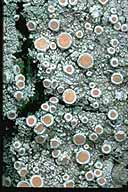Lichens of North America Information
(formerly www.lichen.com)
Lichens of North America Information |
| Home | The Book | Lichens and Wildlife | Lichens and People | Useful Links |
LICHEN BIOLOGY AND THE ENVIRONMENT
THE SPECIAL BIOLOGY OF LICHENS
Go to Lichen Vocabulary (A discussion of lichen growth forms and structures)
Go to Lichens and Ecosystems (Nutrient cycling, soils, and environmental monitoring with lichens)
Lichens are composite, symbiotic organisms made up from members of as many as three kingdoms.
The dominant partner is a fungus. Fungi are incapable of making their own food. They usually provide for themselves as parasites or decomposers.
"Lichens are fungi that have discovered agriculture"-- lichenologist Trevor Goward.
The lichen fungi (kingdom Fungi) cultivate partners that manufacture food by photosynthesis. Sometimes the partners are algae (kingdom Protista), other times cyanobacteria (kingdom Monera), formerly called blue-green algae. Some enterprising fungi exploit both at once.(Click on photos for enlarged views.)
 Lobaria pulmonaria (left) and
a section through it (below) that shows a layer of green algae under an
outer skin of fungus, a dark brown internal clump of cyanobacteria (called
a cephalodium), and a non-sexual reproductive structure called a
soralium.
Lobaria pulmonaria (left) and
a section through it (below) that shows a layer of green algae under an
outer skin of fungus, a dark brown internal clump of cyanobacteria (called
a cephalodium), and a non-sexual reproductive structure called a
soralium.
Cyanobacteria can take nitrogen gas from the air and turn it into biologically usable compounds, so lichens with cyanobacteria can make major contributions to soil fertility.
Little balls of algae wrapped in threads of fungus (called
soredia) emerge from the soralium to be dispersed.
 Section through Lobaria pulmonaria.
The dark lump is a cephalodium and the crown-shaped structure on the right
is a soralium with little ball-shaped soredia on top. The green layer is
the colony of algae.
Section through Lobaria pulmonaria.
The dark lump is a cephalodium and the crown-shaped structure on the right
is a soralium with little ball-shaped soredia on top. The green layer is
the colony of algae.
Reproduction can be tricky for a compound organism. Some lichens make entire non-sexual reproductive packages in the form of soredia (see above) or isidia, which are tiny projections from the surface of the lichen that can break off easily and grow into a new lichen. Most lichens are very brittle when they're dry, and some depend on just plain breakage to produce fragments that, like soredia and isidia, can be blown around by wind, washed along by water, or carried off as passengers on insects or birds.
 Other lichen
fungi make spores. These white-rimmed, peach-colored disks of Ochrolechia
oregonensis are fruiting bodies (called apothecia), where the fungus
produces spores. Also see the photo of a section through a lichen fruiting
body in Lichen Vocabulary
Other lichen
fungi make spores. These white-rimmed, peach-colored disks of Ochrolechia
oregonensis are fruiting bodies (called apothecia), where the fungus
produces spores. Also see the photo of a section through a lichen fruiting
body in Lichen Vocabulary
To form a new lichen, these fungal spores
need to capture new photosynthetic partners after they germinate. Some apparently
steal them from other lichens. Others have the good luck to happen upon
appropriate partners. In all probability, most just perish alone.
Lichens grow in the leftover spots of the natural world that are too harsh or limited for most other organisms. They are pioneers on bare rock, desert sand, cleared soil , dead wood, animal bones, rusty metal, and living bark. Able to shut down metabolically during periods of unfavorable conditions, they can survive extremes of heat, cold, and drought.
 Given appropriate amounts of
light and moisture, clean air, and freedom from competition, lichens can
colonize almost any undisturbed surface -- like this plastic turn-signal
lens on an abandoned Plymouth.
Given appropriate amounts of
light and moisture, clean air, and freedom from competition, lichens can
colonize almost any undisturbed surface -- like this plastic turn-signal
lens on an abandoned Plymouth.
Most lichens grow very, very slowly, often less than a millimeter per year, and some lichens are thought to be among the oldest living things on Earth.
 Lichens with known, slow growth
rates, like Rhizocarpon geographicum, have been used to estimate the dates
of geological events such as the retreat of glaciers. Geologist William
Bull of the University of Arizona has been using lichen measurements to
establish dates for huge rockslides in the Sierra Nevada and other places
that were caused by earthquakes.
Lichens with known, slow growth
rates, like Rhizocarpon geographicum, have been used to estimate the dates
of geological events such as the retreat of glaciers. Geologist William
Bull of the University of Arizona has been using lichen measurements to
establish dates for huge rockslides in the Sierra Nevada and other places
that were caused by earthquakes.
As adaptations for life in marginal habitats, lichens produce an arsenal of more than 500 unique biochemical compounds that serve to control light exposure, repel herbivores, kill attacking microbes, and discourage competition from plants. Among these are many pigments and antibiotics that have made lichens very useful to people in traditional societies. (See Lichens and People)
Laboratory experiments have shown that some species of
Xanthoparmelia contain compounds that make it distasteful to slugs. Slugs
are quite fond of some other lichens. See Lichens
and Wildlife for a discussion of the ways that animals, from reindeer
to insects, use lichens.
Go to Lichen Vocabulary (A discussion of lichen growth forms and structures)
Go to Lichens and Ecosystems (Nutrient cycling, soils, and environmental monitoring with lichens)
|